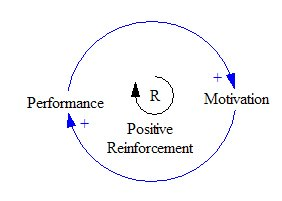We’ve discussed positive reinforcement many times in this blog including my last one on Grandma’s Rule and How the Best Managers and Leaders Deliver Positive Reinforcement.
There are three sources of positive reinforcement.  One I’m quite sure you and most other businesses are missing out on completely.
One I’m quite sure you and most other businesses are missing out on completely.
Whether you realize it or not positive reinforcement as we discussed last blog can actually come from the workplace itself. Let’s discuss the three sources of workplace reinforcement starting with how the workplace can provide it.
- Work-Related Reinforcement: Things that go smoother and easier at work when they are done a certain way will consistently be always done that way. Can you think of a system you might have improved for your team and how once they realized it made their job easier your people persistently followed it? Anytime you can arrange a task that you’re people are performing with positive reinforcement automatically associated with this task it more than likely to be repeated. In most cases however the routine and regiment of a job takes away positive reinforcement. Think of one of your administrative people doing a task each day, followed by the same task over and over. What’s the reinforcement she/he receive for getting this task done quickly, and accurately? Just another opportunity to do more of the same thing. Aubrey Daniels points out that even when positive reinforcement is built into the job, it’s rarely enough to bring out the best in people. Other sources of reinforcement need to be tapped, and we’ll explore those options in another blog.
- Peer-Related Reinforcement: This form of reinforcement while it is the most effective, it’s probably the most underutilized. Only the best companies recognize the value of this and build it into their systems. Most employees don’t recognize that part of their job is actually to positively reinforce their peers. Managers are not even aware that peers can and should be doing positive reinforcement, and when an employee does reinforce another, they fail to recognize this employee so as to help get this activity to continue. One of our employers here in Cedar Rapids, Rockwell Collins uses teams as part of their organizational structure. I’ve spoken to many of the engineers at Rockwell and heard their disappointment with the team arrangement. Few teams operate with the understanding that in this environment peer positive reinforcement is an essential effort that provides performance improvement. As Daniels indicates in Bringing Out the Best in People, “when peers recognize they can and should be a major source of reinforcement for each other, improvement occur more frequently, much faster and last much longer.
- Management-Related Reinforcement: Understand that managers are not responsible for providing all reinforcement in the workplace. This should be understood by the previous two sources of positive reinforcement. Managers do have the overall responsibility for performance and coordinating reinforcement. Managers are responsible for providing appropriate consequences for performance as well. The most important of these is positive reinforcement. Management then should ensure reinforcement occurs for the right behavior, at the necessary frequency and from all sources available. What are the two most important behaviors of supervisors and managers? Planning and delivering positive reinforcement. Capturing discretionary effort in the workplace is the benefit your managers will receive when they harness the power of positive reinforcement.
Do you recall the four to one ratio? That’s the number of “attaboys” to erase one “you really screwed this thing up.” How about the number of reinforcers to teach math? It requires 50,000 reinforcers to teach competence in basic math. How does your workforce positive reinforcement process look when you compare yourself with these numbers?
Some questions to answer as you explore the performance of your workforce. Are you aware and using these three sources of positive reinforcement? Do you have work-related reinforcers that automatically improve your people’s performance? Are you aware of the important role peer related reinforcement can play in your organization? Are your managers aware of it? Are your managers aware and practicing their overall responsibility for performance and coordinating reinforcement?
Do you believe in common sense? Aubrey Daniels is not a believer. We’ll explore the alternative to common sense, scientific knowledge and the six reasons Daniels believes common sense is a weakness as management tool next blog.






.jpeg?width=150&height=135&name=Hand%20with%20marker%20writing%20the%20question%20Whats%20Next_%20(1).jpeg)

